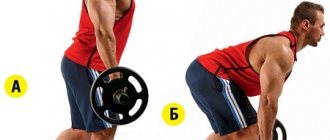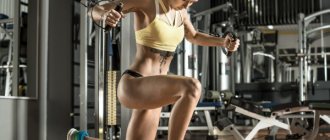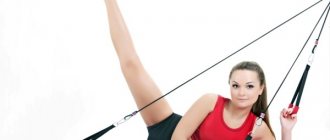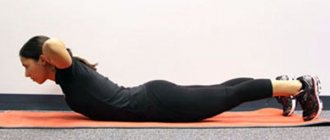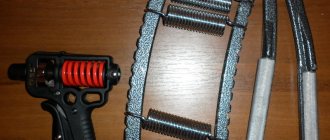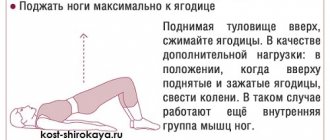What is this
Hyperextension is one of the most useful exercises that helps not only develop, but also strengthen the back muscles in the lumbar region. However, it is only useful if it is performed with the correct technique.
An experienced trainer will always say that there is only one - the only correct execution technique that makes this exercise actually safe and useful.
What is the difference with extension
What is better, extension or hyperextension, we are sometimes asked. Well, it's a touchy question. As a rule, an extension is an exercise in a hyperextension machine in a limited amplitude, without “hyperextension”. Those. confusion is created because It is absolutely wrong to perform this exercise with hyperextension in the lower back.
If we turn to the translation of this word, extension - extension, it becomes clear that it correctly means any extension, no matter what part of the body. In the West, there is an opinion that a mistake crept into the original name of the exercise: instead of “hyper” there should have been “hiper” from “hip” - thigh.
Everything would then fall into place, because extension occurs precisely in the hip joint.
Peculiarities
- Do not lower your body below a level where you feel a comfortable stretch in your hips and back.
- Straighten your back at the top until you feel a comfortable contraction in your back.
- To make the exercise more challenging, extend your arms or grab a weight in your hands and hold it in front of your chest. You can perform the exercise with one leg.
- There are three options for performing this exercise, the names of which are often confused - backextension, hipextension and hyperextension. During back extension, your hips remain motionless, all movement is carried out in the back and lower back. During hipextension, on the contrary, the lower back remains motionless, movement occurs in the hip joint. During hyperextension, movement occurs in all places - in the hip joint and in the lower back.
- The word “hyperextension” means stretching, expanding the limits of movement, and performing this “hyperextension” in combination with serious working weight can be traumatic.
- If you don't have access to a hyperextension bench, perform this exercise on a regular bench.
What muscles work
So, what does the hyperextension exercise do? Some people believe that the main load falls on the buttocks, but this opinion is wrong . In fact, the lower back and the back of the thighs are trained here.
In addition, the shortest muscles of the spine are involved here, which are difficult to load with other exercises.
it is impossible to shift the emphasis to it without getting injured .
- quadratus lumborum muscle,
- core muscles,
- biceps femoris muscle,
- semitendinosus,
- semimembranous,
- hamstring biceps,
- gastrocnemius,
- gluteus maximus muscle.
How the load shifts when performing hyperextension:
Step-by-step illustration of which muscles receive load during hyperextension and at what stage of execution
With the correct technique , the exercise has a low risk of injury, does not overload the joints, maintains muscle tone, strengthens the tendon corset of the spine, and is therefore recommended for beginners and people with weak backs.
What muscles are involved?
- The erector spinae muscle is the target muscle that is most actively involved when performing hyperextension. It is this that is included in the work when the back is extended to parallel with the floor with the 90° option or the body is in a straight position when performing hyperextension of 45°. The erector spinae muscle consists of small bundles that attach to the vertebrae, pelvis and ribs and runs along the entire length of the spine from the pelvis to the skull. Strengthening this muscle improves your posture as it helps maintain proper curves in your spine.
- Hip extensors - consist of the muscles of the back of the thigh, as well as the buttocks, are included in the work in both options for performing hyperextension (45° and 90°). These muscles, like the core muscles, tend to weaken due to modern sedentary and sedentary lifestyles. Hyperextension can wake them up from sleep and strengthen them during exercise.
- Neck extensors are small but very important muscles that are located on the back of the neck and provide its mobility. You need to strengthen these muscles, especially if you spend a lot of time at the computer. They can be activated by placing your hands on your head or neck during the exercise; this position of the hands adds complexity to the exercise.
Benefit
What is it for, this hyperextension of yours? The answer is simple: try doing it at least once, and you will have the feeling that you went to a first-class specialist for a massage! This exercise is great for relieving tension and muscle triggers and providing a feeling of relief.
Everyone who does sedentary work knows how important it is to quickly and efficiently warm up after a hard day. Hyperextension will help you with this!
This exercise is very important for beginners who love strength training, because they have weak back extensors, which are easily injured in serious multi-joint exercises . And hyperextension is an excellent exercise for strengthening these same muscles.
In general, this is an excellent back trainer that is easy to use even for beginners!
For scoliosis
The exercise will also be useful for people who have back problems .
Hyperextensions reduce the risk of injury to the spine and tendons, as mentioned above, and people who have problems can gradually strengthen their lower back. This exercise will be especially useful for people suffering from osteochondrosis and scoliosis. With regular exercise and exercise in general, they will develop beautiful posture.
For hernia of the lumbar spine
The advantage of hyperextension for your back is that it trains not only the muscles directly related to this area of the body, but also those surrounding it: the abs, buttocks, legs. Their training helps strengthen the entire back as a whole.
Sports for spinal hernia
For people with a hernia in the lower back, symmetrical and mixed loads are recommended: swimming, Pilates, yoga, exercises with a fitball, Nordic walking. The optimal type of sport and set of exercises are selected individually depending on the stage of herniated discs, the severity of pain and spinal symptoms, treatment objectives, the presence of concomitant diseases, contraindications, and the patient’s age.
Below we will consider in detail the influence of each sports discipline on the condition of the musculoskeletal system and the course of lumbar intervertebral hernia.
Swimming and water aerobics
In the early period of treatment for residual pain syndrome, water aerobics is recommended. Physical exercise in water is beneficial not only for the spine, but also for general health. Frequent exercises help increase the strength of the back muscles, the flexibility of the ligaments, eliminate pain, and normalize weight, which is extremely important in the presence of a hernial protrusion. Extra pounds create additional stress on the spine and provoke an increase in protrusion of the intervertebral disc beyond the boundaries of the vertebral bodies.
As general well-being improves and motor activity in the lumbar region is restored, swimming is allowed. It is recommended to swim on your back or breaststroke. If you are in satisfactory physical shape and have no diseases of the respiratory system, heart or blood vessels, you can use free swimming.
A comfortable water temperature for exercise is 25-28 degrees, but not lower than 20 degrees, in order to prevent hypothermia of the body and not provoke a new relapse. The recommended duration of training at the initial stage is 30-45 minutes; subsequently, the training time can be increased to 1.5 hours.
Pilates
Regular exercises help strengthen stabilizer muscles, thereby ensuring the normal position of the vertebral bodies, improve flexibility, develop coordination, and establish correct posture. As a result of training, blood circulation is also stimulated, metabolism is activated, pain goes away, and the load on the damaged disc is reduced.
Yoga
Physical exercises develop flexibility of the spine and improve the health of the whole body. The ultimate goal of yoga for herniated intervertebral discs is different: improving physical health, eliminating pathological muscle spasms by activating blood circulation, restoring motor activity, and preventing new relapses.
By overestimating the capabilities of your body and trying to perform complex poses at once, you can get physically injured as a result of yoga. Therefore, the treatment program should be drawn up by an experienced instructor in the case of a specific patient, taking into account the physical fitness and age of the person. Head and shoulder stands, deep bends back and forth, and handstands are contraindicated.
Fitball
Exercises with a fitball help correct posture, increase flexibility, and improve coordination. The round shape of the ball allows you to perform movements with a greater amplitude, and its instability forces you to keep your back muscles in constant tension, thereby increasing the strength in the muscles that straighten the spine. Other positive aspects of exercising with a fitball are improving the functions of the respiratory, nervous, and cardiovascular systems, overall health of the body, stimulating blood circulation, and reducing the load on the affected disc.
Spinal stretching exercises
With the help of spinal stretching exercises, the space between the discs increases, the load on the affected segment decreases, which promotes some recovery of the disc and stops the progression of the hernial protrusion.
Regular exercise also helps relieve the pressure of a herniated disc on surrounding tissues, the spinal canal, and vertebral artery, and restore normal nutrition and blood circulation in the disc tissues. As a result of increasing the intervertebral distance, pain goes away, swelling subsides, and range of motion in the lumbar region is restored.
Gym classes and exercise equipment
People with an intervertebral hernia in the lumbar region, outside the period of exacerbation, can exercise in the gym with benefits for the back, most importantly without axial load on the spine. The wellness and rehabilitation program includes exercise on exercise bikes. Cardio exercises are necessary to maintain good external shape, help develop endurance, improve blood circulation, and strengthen leg muscles.
You can do bench press, overhead pull-downs, horizontal pull-downs,
swing dumbbells to the sides, exercise “cat”, raising legs from a position lying on your side. For small hernias uncomplicated by radicular syndrome, leg presses are allowed. The exercise develops the muscles of the legs, increases the flexibility of the ligaments and the strength of the gluteal muscles, and relieves stress from the lower back and back.
But strength training for hernial protrusion in the lower back is contraindicated. Exercises with a vertical load on the spine can provoke displacement of the intervertebral discs and compression of the spinal nerve.
Hyperextension
This is a physical exercise to develop the back muscles, gluteal muscles, and hip flexors. The objectives of the technique are to increase the flexibility of ligaments and muscle strength, normalize metabolism, ensure the necessary supply of oxygen to tissues, and correct correct posture, which is extremely important for preventing exacerbation of lumbar hernia.
If the hyperextension technique is violated, you can injure your back and strain your muscles, which will require a long recovery. For people with a hernia in the back, the optimal classic option is horizontal hyperextension. The exercise can be done at home while lying on the floor.
Plank
This is a physical exercise to strengthen the abdominal and back muscles. If you follow the technique, you can improve your overall physical fitness, increase endurance, and form correct posture. The exercise must be started with the easiest option and mode for 15 seconds, doing 3-4 repetitions. Gradually increase the time spent in the plank to 1-2 minutes.
Walking, Nordic walking
Nordic walking with poles shows good results in the treatment and prevention of hernia in the lumbar spine. Effect of classes:
- maintains muscle tone of the upper and lower body;
- relieves muscle tension;
- forms a strong muscle corset;
- improves balance and coordination;
- promotes weight loss;
- activates the work of the cardiovascular system and respiratory organs;
- reduces the load on the spine and joints.
To feel the results of your training, it is important to immediately find the right pace of movement and choose the right poles. Conventional walking is inferior in efficiency to Scandinavian walking.
Horizontal bar, pull-ups
Hanging on a horizontal bar for a lumbar hernia has a good effect: it increases the intervertebral distance, reduces the load on the damaged disc, strengthens the back muscles, and improves blood supply. It’s good to combine hanging on the horizontal bar with pull-ups. The exercise develops the muscles of the upper back, pectoral muscles and forearms, and the muscles of the abdominal wall. In addition, it increases the flexibility and elasticity of soft tissues, restores the motor functions of the lumbar spine.
When?
- as a warm-up. With its own weight, additional burden in no case do not take. This way you warm up your muscles before serious exercise.
This is a controversial option, since you are creating possible instability of the vertebrae, which you will finish off with the base. It is better to stretch the spine in joint gymnastics, where from a standing position you bend the spine in different directions.
- as a finishing exercise for the back.
Accordingly, after basic exercises, there is no risk as such.
- as a main weight training exercise. To be honest, we don't like this option. Weights that are especially “decent” for you in an exercise in which the body is in an unstable position, and even when bending the lower back, are not a good idea.
If you really want to do hyperextension with weight, then take a maximum of average working weight.
How to do the plank exercise correctly: analysis of the technique with photos>
Types of benches for exercise
There are several types of hyperextension and, accordingly, different machines for each of them. Let's look into them!
- Horizontal is a good option, but in our opinion, performing the exercise in this version is not as convenient and safe as in the classic one.
- A bench for abs and hyperextension is the most versatile and compact option; this exercise machine is especially good for home use.
- The reverse hyperextension machine is for those who want to put more stress on their buttocks and thighs.
- The classic inclined machine is the most common and safest machine for performing the exercise.
- roman chair
Some craftsmen manage to create a homemade exercise machine for their home with their own hands! But let's quickly find out how to properly exercise on different types of exercise equipment?
Hyperextension at home
Despite the fact that many people believe that hyperextension at home without exercise equipment will not give the same effect as doing the exercise in the gym, this is not true. There are ways to perform the exercise that allow you to get results no worse if the technique is correct. Let's consider popular options
Hyperextension on a horizontal surface
For such an exercise, hyperextension at home, you can use ordinary chairs or stools placed together. Or you can do it on the couch. The execution technique in this case will be as follows:
- You need to sit face down on the support so that only your thighs rest on it. The body should hang down quite freely, but the head should not touch the floor. Feet should rest on the floor. The feet must be properly fixed or asked for someone to hold them.
- Inhale, lift your body so that your body and legs form a straight line. Stay in this position for a few seconds. Come back as you exhale. It is recommended to repeat the exercise in three sets of 10-15 times.
Hyperextension on the floor
Hyperextension without a machine can be performed simply while lying on the floor . In this case, you do not need to fix your legs or ask anyone for help. The exercise is done as follows:
- You need to get down on your stomach on the floor. Place your hands on the back of your head or cross them over your chest. Feet must be kept together.
- Inhale, lift your body as high as possible. Don't lift your hips off the floor. Stay in this position for a few seconds.
- As you exhale, come back. Repeat the exercise 10-15 times, do three approaches.
Arm and leg raises
Hyperextension at home without a machine in this variation is also performed while lying on the floor. The algorithm for doing it is as follows:
- Lie on your stomach on the floor. Place your hands in front of you and keep them straight. Feet must be kept together.
- Inhale and simultaneously raise your arms and legs as high as possible. During this process, your hips should be pressed firmly to the floor.
- As you exhale, return to the starting position.
Hyperextension on a fitball
The hyperextension exercise at home can be performed using a fitball. It is done as follows:
- Lie on the ball so that your thighs and lower abdomen are pressed against it. Place your hands on the back of your head, place your feet at shoulder level, rest your feet on the floor. The body must be kept straight without touching the surface of the ball.
- Inhale, lower your body, while rounding your back. Make sure your chest is well pressed against the ball.
- Exhaling, return back to the starting position.
Performing hyperextension on a stability ball may seem difficult to many because it requires balancing. But it remarkably improves coordination and allows you to use small stabilizer muscles.
Reverse hyperextension
You can also perform reverse hyperextension at home, which places more of the load on the muscles of the buttocks and thighs. Here, in the question of how to do hyperextension at home, you will need a table . It must be stable, otherwise you may fall and injure yourself. This exercise is done as follows:
- You need to position yourself on the table so that the entire body rests on the support. Your legs should hang down. Hold the edge of the table with your hands.
- As you inhale, raise your legs as high as possible. Only the legs should move, and the body should remain motionless.
- Exhale and return to the starting position.
Hyperextension at home, a video of which will show you several more effective ways to do it, can be very effective with regular exercise.
Execution technique
For the back
So, how to do back hyperextension correctly?
Classical
We will consider the most popular option, when the work takes place on a special simulator - a Roman chair , at an angle of 45 degrees. The step-by-step sequence of actions is as follows.
- Starting position: go to the simulator, adjust its height to suit your height, namely: front bolsters must be positioned exactly at the bend of the lower back and hips, bottom rollers must be just above the Achilles tendon.
We do not recommend short hyperextension, with emphasis under the very hips - this makes it easier to lose balance during the execution and is generally uncomfortable.
Place your feet under the lower support roller. The back is flush with the line of the legs. The start begins from this position.
- How to do it correctly: powerfully tighten your gluteal muscles and “break” at the waist through the machine. Tilt your body down slightly, to about a 60-degree angle. At the lowest point of the trajectory, cross your arms over your chest and smoothly (without jerking) lift your body up to a straight line with legs
.
Avoid hyperextension in the lower back. Hold this position for a second (feel the peak contraction) and repeat the movement again. Breathing technique: inhale as you lower, exhale as you rise.
This is the only true and safe option.
Here the height of the supports is at the level of the subgluteal fold, the working muscle groups are dynamically the buttocks and the back of the thigh, and statically the back extensors. There is no hyperextension of the spine (the body rises to the plane of the hips), and at the lowest point the back is not rounded .
Throughout the entire range of motion, the natural deflection of the spine in the thoracic and lumbar regions is maintained. It is difficult to track the technique on your own; you need to do it with a stick, and have someone watch from the side (preferably a coach).
Terrifying deflection
Analysis of the most effective abdominal exercises
Reverse
As a simulator for a reverse variation of this exercise, you can use a gymnastic goat, a Roman chair, a bench or a special one. device In all these options, your “support” will be your own abs!
The advantages of this option for performing hyperextension: a much greater load on the gluteal and thigh muscles, the abs and arm muscles are also statically tensed, but the risk of back injury is minimal - the load in this position is gentle.
By the way, this particular version of the exercise is universally rehabilitative for people with back problems: due to the fact that the body lies on the exercise machine, the load is removed from the spine.
So if you have injuries, but want to load the muscles of your back and buttocks, choose this option!
The technique for performing reverse hyperextension is simple and straightforward:
- Starting position : the torso is on the machine, the legs are slightly raised, the hips and buttocks are tense.
- As you exhale, we raise our spread legs until we feel a peak muscle contraction: for some it is more comfortable to lift to parallel with the hips, for others it is much higher than the body. The main thing in this case is your sensations and comfort.
Please note that lifting should be carried out using force on the buttocks and thighs. Do not make sudden movements: everything should be smooth and carefully controlled.
- Stay in the peak position for 1-2 counts, then, while inhaling, slowly and “thoughtfully” lower your legs to the starting position. Repeat the required number of times.
On the uneven bars
An option for original people or those who really love parallel bars:
On fitball
At home without a gym
So, how can you do the classic exercise and reverse hyperextension at home without machines?
Horizontal on the floor
In general, this exercise is most likely well known to you under the name “boat”. The technique is simple, but the effect is good - by performing the boat, you can effectively “stretch” the quadratus lumborum muscles and back extensors.
The biggest advantage of this exercise is that it is both a classic and a reverse variation.
Technique for performing hyperextension at home on the floor:
- Starting position: lying on your stomach, legs and arms straight and extended.
- How to do it: as you exhale, raise your head, upper body with arms and legs so that your body is not uncomfortable. Remember that hyperextension is bad and harmful to your lower back! Return to the starting position and repeat as many times as necessary.
- Very important: movements should be smooth, no sudden jerks or jerks, this is dangerous for the spine!
This is the wrong technique! There is no need to try to break across, otherwise you never know what will happen.
On the couch
We are categorically against such tricks! All this advice like “get a family member to sit on your feet” or “put down a weight” is extremely dubious. This is an inconvenient and messy version of the exercise that will not bring you any benefit, but it can cause injury!
Just imagine how “wonderful” it will be for you to stick your nose into the floor when the load turns out to be light or poorly secured and falls off your feet. The person may also well be unable to hold you in the desired position.
On the buttocks with a round back
Degree of tediousness : decent, MUST READ. So, let’s discuss the technique “for girls,” as some trainers put it—gluteal hyperextension or technique for the buttocks.
One of the most serious problems in sports (even in home workouts) is the risk of injury to the spine due to incorrect exercise technique, failure to respect the principle of individuality, and the promotion of obviously incorrect exercises ! The last one is the most outrageous!
There are stories on the Internet from all sorts of “experts” that with the help of hyperextension, if you bend in a special way, you can only pump up the gluteal muscles, relieving tension from the back muscles. It is not true . Even if you tie yourself in a sea knot, you will only achieve one thing: back pain and problems with the spine
- Hyperextension on the buttocks with rounding of the back at the lowest point.
Working muscle groups - the back of the thigh, buttocks and spinal extensors in dynamics. The exercise is performed with rounding of the back at the bottom point and hyperextension at the top point + often with inertia and additional weight. Complete, crooked madness, and with weight on top of that!
The lowering of the body occurs too low and there is a large deflection of the body at the top point (during the lifting phase). The back arches dangerously back at the top.
Add to this work at full amplitude, when a person begins to make pendulum movements of the body, swaying back and forth.
This is the most traumatic option , where the entire spine is affected - the fibrous ring, spinal ligaments, tendons of the leg muscles. Severe instability of the spine occurs and the vertebrae may shift over time due to osteochondrosis. Destroyed spinal ligaments cannot be restored, just like the fibrous ring.
Never do this and send everyone who advises you to do so!
- Hyperextension on the buttocks with constant rounding of the back.
The height of the stand is set at the level of the subgluteal folds in order to tilt the pelvis forward, relative to the hips, i.e. you bend very low . The amplitude is again incorrect. The thoracic region is initially rounded and this position is maintained throughout the entire movement of the body.
Here, beginners often have a rounded lumbar region. From the outside it looks like a huge question mark has decided to pump up for the summer.
Working muscle groups - the back of the thigh, buttocks in dynamics, back extensors in statics. When rounding the lower back, the back extensors work dynamically. If we exclude the rounding of the back, the exercise becomes less traumatic, but not safe .
This technique is considered incorrect and excluded from the arsenal of exercises, but someone, somewhere did it once and the wave washed over it. It turns out a similar situation with rounding the back during deadlift , which experienced practitioners are afraid of (rounding).
And at the lowest point, when lowering the body, a stretch occurs in the extensor muscles of the spine, including the cervical spine, and additional tension in the entire spine.
Thus, this exercise increases osteochondrosis, which many people have, and in a healthy spine causes instability of the vertebrae in the thoracic region , due to stretching of the posterior longitudinal ligament.
Exercises for severe forms of coxarthrosis
This set of exercises for coxarthrosis is based on the method of V.D. Gitta. This complex can be recommended both in the initial stages of the disease and in more severe cases.
Exercise for coxarthrosis No. 1
It’s best to do it on the floor, after laying down a rug or blanket, but you can also do it on the sofa.
You need to lie on your stomach, put your hands under your head or extend them along your body. You can place a small pillow or cushion under your feet. Relax as much as possible. As you roll on your stomach, sway your hips slightly left and right. The range of movements should not exceed 2-3 cm. Do not strain your muscles or try to lift your pelvis. If you feel the slightest pain, reduce your range of motion and try to relax; Determine by experience the most suitable distance between the heels.
This exercise for coxarthrosis is performed 3 times a day for 10 minutes (before meals). Particularly weak patients should start with 3-5 minutes 2 times a day and gradually increase its implementation to the full program. Rotational movements help improve nutrition of the hip joints. But for people who have been without normal physical activity for a long time, even such a simple exercise is sometimes difficult to perform correctly. Therefore, at first it is advisable to do it under external control or passively, with the help of an operator.
The benefits of exercise are not limited to the joints. Its implementation helps improve intestinal motility, while the liver, gall bladder, stomach, pancreas and other organs are massaged. In overweight people, the stomach tightens, the waist size decreases and the appetite decreases. Diabetes often improves.
If your knees are sore and swollen, you may feel pain in them. In this case, you need to place something soft under your knees.
The exercise can be performed even with the most severe forms of the disease, because the leg muscles are not involved and the movement in the joint is passive.
Exercise for coxarthrosis No. 2
Performed lying (reclining) on your back.
Extend and spread your legs slightly, alternately turning them outward and inward. The range of movements is extremely small - no more than 0.5-1 cm. It is advisable to place a small pillow under the knees.
If you experience pain, you need to reduce the range of motion, change the width of your leg spread and relax as much as possible.
The exercise will appeal to couch potatoes, because while doing it you can read, watch TV, and talk.
Exercise for coxarthrosis No. 3
This is the most versatile and easiest exercise for coxarthrosis . Performed while sitting. You can do it at home, at work, in transport and even in the theater.
Sit comfortably. Your knees should be approximately shoulder-width apart and your feet flat on the floor. Bring your knees in and out easily and without tension. The range of movements is 0.5-1 cm. In the initial stage (to control the range of movements), it is better to keep your hands on your knees, and after acquiring skills, anywhere.
If you feel pain, try to reduce the range of motion, place your legs a little narrower or wider, change the frequency of movements, relax.
The total time for performing the exercises is from 3 to 6 hours. You shouldn't do them all at once, one after the other. It is advisable to distribute it throughout the day. All exercises are similar in their effect. Which one to do depends on your capabilities and desires.
Exercise for coxarthrosis No. 4
This exercise for coxarthrosis is intended for the weakest patients who cannot sit, get out of bed onto the floor or lie on a table. Make a loop from a wide belt or towel. Hang it above the bed, at your feet, at a height of approximately 25 cm. Lie on the bed and insert your sore leg into the loop, approximately to the middle of your calf. Completely relax your leg and swing it slightly left and right or bending and unbending at the knee. The movement is performed with minimal amplitude.
Of course, the above exercises are useful for any degree of coxarthrosis , and not just for severe ones. And the following exercise is recommended to be performed only in the initial stages of the disease - no higher than 2nd degree.
Exercise for coxarthrosis No. 5
Performed while standing. Stand with your healthy leg on a slight elevation, while the patient should hang down as much as possible. Rock your affected leg back and forth and left and right. Be sure to hold onto a support (or wall). It is advisable that the affected leg be on the opposite side of the support. Do it 2-3 times a day for 5-10 minutes. Painful sensations are not allowed.
The most important! None of the recommended exercises should cause pain. If you feel pain, stop the exercise! Pain is extremely harmful to your joints.
Read more about NANOPLAST forte
What to replace
So, if you don’t have a hyperextension machine in your arsenal, then the following exercises are suitable for you:
- An excellent exercise for developing back muscles: Good morning: bending over with a barbell on your shoulders . This movement is as close as possible to the hyperextension technique!
- “Boat” or “Superman” , described above.
- Plank : details about this exercise in the article How to do the plank exercise correctly: analysis of the technique with photos
- “Cat” is a good option for those who want to relieve tension from the back muscles and properly relax them after a long period of sitting. It’s extremely simple to do, there are no pitfalls in the technique.
How to replace hyperextension at home: exercise options
Also, on the question of how to do hyperextension at home, you can pay attention to exercises that are similar in their action and work the same muscle groups.
Exercise Good morning
The good thing about an exercise called “good morning” is that it allows you to load your lower back exactly as much as needed, which is something that regular hyperextension cannot always allow.
It is important to ensure that your back is straight when performing the exercise, and that a natural deflection is maintained in the lower back. Due to your lack of flexibility, you may not be able to do deep forward bends right away, so do the exercise as far as stretching allows.
If you use weight for the exercise, keep it light so that your lower back is not overloaded. Movements should be smooth and slow, and the weight should be located in the shoulder blades or on the rear delts.
Plank exercise
The plank is a wonderful static exercise for the lower back, in which almost all the muscles of the body will be evenly loaded. The main emphasis when performing it lies on the stomach, but the lower back also works fully, being responsible for stabilization. The plank also allows you to use deep muscles that are not used in other exercises. The plank can be performed both on the elbows and on outstretched arms, changing the angle of inclination, load and working muscles.
The body should be straight when performing the exercise. The entire body from head to heels should be in a straight line.
Exercise cat/dog
It is also a good and effective exercise that can replace hyperextension if done correctly. At the same time, it is quite simple. The exercise gives less load, but it is useful in that it allows you to relieve the load on your back. It is especially suitable for those who sit for a long time or often place axial loads on the spine. Exercise helps to stretch the abdominal muscles and improve their tone. In addition, it is suitable for everyone, regardless of level of training, and can be performed in any conditions.
Hyperextension exercises at home, with videos showing you how to do them, can work just as well as going to the gym. It is only important to master the correct technique and practice regularly, and then the benefits for both health and figure can be invaluable.
Important nuances
- In all variants, the calf muscles work statically. not be completely straight at the knee joint ; they should be kept slightly bent to avoid hyperextension of the popliteal ligaments and instability of the knee joint.
- The cervical spine is the most vulnerable; you cannot put a barbell/dumbbells or weights on it (yes, yes, I personally saw this)! The barbell is placed just below the trapezius!
- If we do hyperextension with weights, we lift the weight off the floor, and don’t climb on the simulator with him. For some reason, people often perform such perversion, although it is obvious that it is dangerous and simply inconvenient!
Those. took the starting position, picked up a plate/dumbbell/brick and began to perform the exercise. This is the only way, otherwise sooner or later you will pick your face off the floor.
- Hyperextensions with spinal rotation ( vertical rotation ) should also be excluded due to the increased risk of injury.
- An absolute contraindication to all hyperextensions is an intervertebral hernia on a thin stalk at the back of the spine, which can fall off into the spinal canal and put pressure on the nerves.
- It is important to work the gluteal muscles through the entire range of motion and stretch the hamstrings. In order for the gluteal muscles to work well, they need to be activated with other exercises, and at the top point they need to be further strained by contraction. But gluteal hyperextension as such does not exist!
- In no case do we round our back.
- And of course, we don’t chase the scales. First, work “idle”, gradually adding weight, you will always have time to kill yourself.
How to do hyperextension correctly: options for performing the exercise?
With a bench angle of 45°
- To begin, adjust the machine so that nothing hinders the movement. Place the sheaves tightly in the places provided for them.
- Cross your arms in front of your chest and begin the exercise from a straight body position.
- Bend at the waist and slowly lower your body towards the ground at an angle of about 65°-75°.
- Pause briefly in the bottom position and then slowly rise up to the starting position until your back and legs form a straight line.
45° with extra weight
As you perform 45° incline hyperextensions regularly over time, you will notice that it becomes too easy because your muscles have become accustomed to the load and become stronger.
In order to complicate the workout, take additional weight in your hands and perform it with weights, for example, with a weight plate in your hands or with a barbell, which can also be held in front of you or placed behind your head.
Hyperextension 90°
Although this variation of the exercise may seem a little intimidating at first, it is ideal for those at an intermediate to advanced level. The difficulty is higher compared to the 45° hyperextension, since the movement is carried out from the bottom point, where the body completely hangs from the bench, and at the top point of the amplitude the body slightly passes the horizontal mark.
If this is your first time doing hyperextensions, don't be afraid to lean toward the ground. If it’s convenient, use your hands to support yourself while doing it until you get used to it. The bolsters that support your legs in the calf area will prevent you from falling. Make sure that the top platform of the machine is at the level of the very top of your thighs, does not rest on your stomach or legs, and allows you to freely perform the exercise.
While performing the exercise, do not get carried away with speed and amplitude. Move slowly, at the top of the amplitude, limit the movement to the point where the body forms a straight line. When performing a 90° hyperextension, you can increase the range of motion slightly, but not too much to avoid injury.
With an emphasis on the back
Make sure your feet and ankles are firmly planted and your hips are pressed firmly into the top platform. The lower back should be in front of the platform and during the movement at the bottom of the amplitude you should feel a stretch in the hamstrings. If you notice that the flexion is predominantly in the lower back and you cannot flex at the hip joint, lower the upper plate lower.
With an emphasis on the buttocks
This option will be more interesting for girls who want to pump up their butt. Start the movement as shown in the illustration - with a round back. Cross your arms in front of your chest or use them to support additional weight.
As you perform the exercise, keep your upper back rounded and your chin tucked toward your chest. Pause for a second at the bottom and try to feel the tension in your gluteal muscle as you rise to the starting position. Concentrate on working your buttocks while performing the movement with a rounded back, the neuromuscular connection in this version of the exercise is of utmost importance.
With an emphasis on the hamstrings
Start moving as shown in the illustration. Cross your arms in front of your chest or use them to support additional weight.
While performing this version of hyperextension, straighten your chest and keep your back straight, pull your shoulders back and keep your head in a neutral position, do not tuck your chin. Go as low as possible while stretching your hamstrings. The range of movement largely depends on individual flexibility.
At the bottom, pause for a second and, maintaining emphasis on the back of your thighs, slowly rise to the top position.
Hyperextension on a fitball
If you do not have the opportunity to perform hyperextension on a bench due to its absence in your gym, you can use a fitball. One of the advantages of a fitball is the ability to practice with it at home, but be careful, maintaining balance on the ball is much more difficult and the likelihood of injury is higher.
Watch a video that explains how to use a stability ball to perform hyperextension:
Hyperextension to strengthen the lower back muscles
Hyperextension is one of the main exercises that is designed to strengthen the back. It creates a dynamic stretch in the lower back, allowing you to feel changes literally within a few days. And perhaps the most important advantage of this exercise is that you can perform it at home.
I have injured my back twice in the last 10 years, once very seriously. It was a very difficult and exhausting time. After a serious incident, I spent my days lying in bed with my legs in the air, and my nights endlessly tossing and turning in bed, trying to find a comfortable position. Every day was torture, it was a fun time.
I learned a lot from this. In both cases, the orthopedic doctors advised me to do hyperextensions to strengthen my lower back. This was necessary in order to recover from the injury received, as well as in order to avoid injuries in the future.
I guarantee that hyperextension is effective. If I don't do this exercise for a week (for example, on vacation), my back starts to ache, always in the same place - lower left. Once I get back to doing hyperextensions regularly, my back starts to feel like it did when I was 18 years old. Incredible!
I'll tell you how to get the most out of the exercise. Doctors shared these secrets with me when I was undergoing treatment and restoring the health of my back.
I went to see my doctor twice a week for a month and a half and asked each time, “Will this get me back to my old life?” I doubted that hyperextension would completely restore the health of my back, but I actually felt better. It only took 6 months.
Stretching and warming up
Warm-up stretching is extremely important to do before every workout.
- 2 - 3 minutes of cardio is necessary to get the blood moving through the body and warm up your muscles (jogging in place, exercises with a jump rope, exercise bike)
- 2 minutes of dynamic stretching will prepare the muscles for work (walking with raised knees, arm rotations, side bends, body rotations)
Starting position:
- Take a face-down position on a hyperextension bench, secure your legs with stops;
- Most machines will place your body at a 45° angle to the floor.
- Cross your arms in front of your chest and make sure that your lower back is free from support and you can easily bend at the waist.
Technique:
- lower your upper body down, bending at the middle of your body;
- lower your body until you feel a stretch in your hamstrings, exhale as you lower;
- at the lowest point the body should be almost perpendicular to the floor;
- slowly rise to the starting position until your body forms a straight line, inhaling as you rise.
Execution Features
Hold at the highest and lowest points for 3 seconds. This will help contract the lower back muscles at the top and stretch at the bottom. Do this during each approach and it will benefit.
Sets/reps/rest
3 sets / 8-12 reps / 1 minute rest.
The number of repetitions can vary greatly depending on your fitness level and back health. If you want to make the exercise more difficult, take additional weight and press it with your hands to your chest. Make sure you have warmed up well before performing the exercise.
